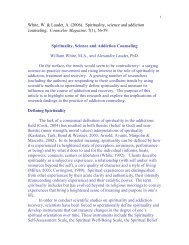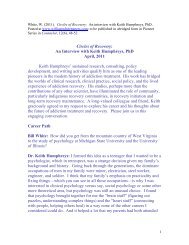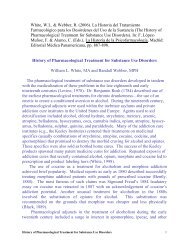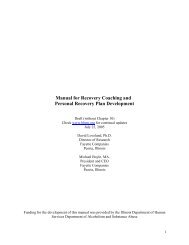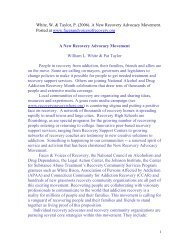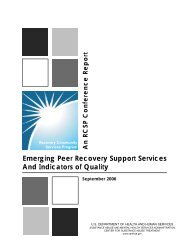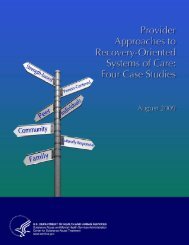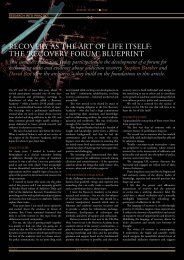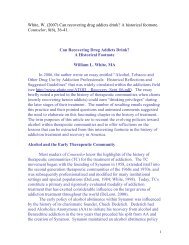Recovery Management and Communities of Color: - William L. White
Recovery Management and Communities of Color: - William L. White
Recovery Management and Communities of Color: - William L. White
Create successful ePaper yourself
Turn your PDF publications into a flip-book with our unique Google optimized e-Paper software.
4When people are taught to hate themselves, they will do bad things tothemselves. --S<strong>and</strong>ers 1993.Acute care (AC) models <strong>of</strong> intervention have assumed that the sources <strong>and</strong>solutions to AOD problems reside within the individual, <strong>and</strong> that briefinterventions to alter an individual’s physical, cognitive, <strong>and</strong> emotionalvulnerabilities can produce a permanent resolution <strong>of</strong> these problems. RMmodels posit that AOD problems spring from multiple, interacting etiologies;unfold (suddenly or progressively) in highly variable patterns; ebb (remission)<strong>and</strong> flow (relapse) in intensity over time; <strong>and</strong> are resolved at different levels(from full to partial) via multiple long-term pathways <strong>of</strong> recovery. People <strong>of</strong>color may be at risk for AOD problems, but these risk factors differ between <strong>and</strong>within ethnic groups (Matsuyoshi 2001).The RM model suggests that historical, political, economic, <strong>and</strong> socioculturalcircumstances can also serve as etiological agents in the rise <strong>of</strong> AODproblems. Client discussions about cultural pain (e.g., slavery, the loss <strong>of</strong> l<strong>and</strong>,attempted extermination, epidemic diseases, the purposeful break-up <strong>of</strong> tribes <strong>and</strong>families, the loss <strong>of</strong> families <strong>and</strong> culture via immigration or forced deportation,forced internment as prisoners <strong>of</strong> war, other forms <strong>of</strong> physical sequestration,immigration distress, acculturation pressure, racism <strong>and</strong> discrimination) areviewed, not as defocusing or acting out, but as a medium <strong>of</strong> a consciousnessraising <strong>and</strong> catharsis that can open doorways to personal/community healing <strong>and</strong>transformation (Green 1995). This approach is much more congruent withbeliefs within communities <strong>of</strong> color that their AOD problems result as much fromhistorical trauma 1 , economic <strong>and</strong> political disempowerment, <strong>and</strong> culturaldemoralization as from biological vulnerability (Manson 1996; Brave Heart <strong>and</strong>DeBruyn 1998; Brave Heart 2003). Culturally-nuanced models <strong>of</strong> RM reflect anunderst<strong>and</strong>ing <strong>of</strong> the effects <strong>of</strong> intergenerational trauma (grief, rage, self-hatred,self-medication) upon whole communities. Positing multiple pathways <strong>of</strong> longtermrecovery also opens up the potential for culturally prescribed frameworks <strong>of</strong>AOD problem resolution (abstinence-based religious <strong>and</strong> cultural revitalizationmovements, e.g., the Nation <strong>of</strong> Islam) as well as cultural adaptations <strong>of</strong> existingrecovery support structures (e.g., the “Indianization” <strong>of</strong> Alcoholics Anonymous1 Maria Yellow Horse Brave Heart (2003) has defined historical trauma as “cumulative emotional <strong>and</strong>psychological wounding over the lifespan <strong>and</strong> generations, emanating from massive group trauma experiences.”4







